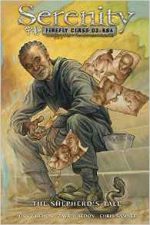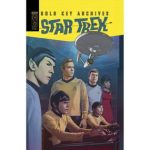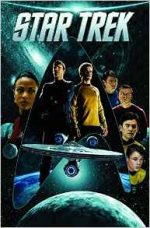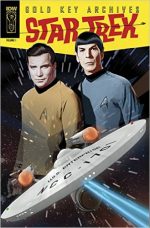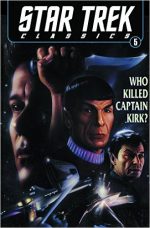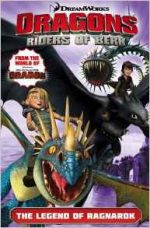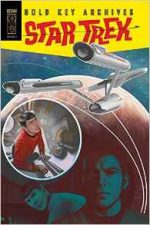
By Len Wein, Arnold Drake, Alfredo Giolitti, Giovanni Ticci & various (IDW)
ISBN: 978-1-63140-231-9
Star Trek debuted on American televisions on September 8th 1966, running until June 3rd 1969: three seasons comprising 79 episodes. A moderate success, the series only really became super-popular after going into syndication; running constantly in American local TV regions throughout the 1970s. It was also sold all over the world, popping up seemingly everywhere and developing a fanatically devoted fanbase.
There was some merchandising, and an inevitable comicbook – from Gold Key – which ran for almost a decade beyond the show’s cancellation. However, at the start neither authenticity nor immediacy were paramount. Only six issues were released during the show’s entire 3-season original run. Published between July 1967 and December 1968, those quirkily enticing yarns were all gathered in the first Star Trek: Gold Key archive collection.
The reason for the inaccuracies between screen and page was simple and a clear indication of the attitude both studio and publisher held about science fiction material. Initial scripter Dick Wood had seen no episodes when commissioned to write the comic, and with Italian artists Nevio Zaccara and Alberto Giolitti, received only the briefest of outlines and scant reference materials from the show’s producers. The comics craftsmen were working almost utterly in a vacuum…
Nevertheless, by the time of these interstellar exploits – reprinting Star Trek #13-18 from February 1972 to May 1973 – most of the well-intentioned contradictions of established Trek lore were long gone, thanks to better reference materials and familiarity with the actual show. These printed Enterprise incidents and missions are far closer to canonical parity with the TV phenomenon.
Following entertaining Introduction ‘Let’s See what She’s Got’ from educator and Trek scholar Joseph F. Berenato, the extra-solar explorations resume with ‘Dark Traveller’ (by Len Wein & Giolitti) which sees the Enterprise taken over by a shadowy being of incredible power who boosts its capabilities to send the crew hurtling across the universe.
Nomad shares his story of a world that grew too perfect and fell into cultural stagnation, and how he abandoned it for more primitive, questing races, before concluding that now his energies are fading his time to return home has come…
However, when he and his unwilling travelling companions reach Utopia, they find no paradise but a ruined world wracked by bloodshed, with mechanical killers everywhere, intent on eradicating the organic population.
Stranded far from home, the Federation crew have no choice but to join Nomad’s brutal war against an old friend driven to madness and mass-murder if they are to have any chance of seeing familiar stars again…
Star Trek #14 from May 1972 reveals how a diplomatic mission goes lethally awry after James Kirk is injured during a landing party excursion. Subsequently tasked with feting an unaligned dignitary whose civilisation and political allegiance is also being courted by Klingon emissaries, the Captain seemingly goes crazy and provokes ‘The Enterprise Mutiny’.
However, canny Mr. Spock deduces there is another explanation for his comrade’s sadistic and erratic behaviour…
August found Enterprise propelled beyond reality by a cosmic maelstrom and latterly becalmed in a region where physical laws don’t work properly. Invited to visit the ‘Museum at the End of Time’ by its uncanny Curator, Kirk, Spock and Dr. McCoy meet explorers from many worlds and eras who have long ago lapsed into immortal indolence. Typically the newcomers cannot reconcile themselves to the fact that there is no escape from the timeless limbo that holds them…
The situation escalates into bloody warfare when Klingons from a battle-cruiser also caught in the cosmic storm invade the museum. As chaos erupts, the time-lost denizens of limbo finally regain their old verve and fight back, just as Spock discovers the timeless realm is dying. The imminent end, however, does present one perilously slim chance of returning to their original plane of existence…
In November an Enterprise shuttlecraft suffered a catastrophic accident and crashed on a primitive, feudal world where the Federation crew had to hide their alien natures from a superstitious, theocratic cult tyrannising the primitive populace. To stand any chance of rescue Kirk, Spock, McCoy and their subordinates had to ally themselves with a resistance movement to escape torture and death on the ‘Day of the Inquisitors’…
With #17 (February 1973), Arnold Drake replaced Wein as scripter and Giolitti split his illustrative duties with studio-mate Giovanni Ticci to solve the riddle of ‘The Cosmic Cavemen’.
On a distant world shared by dinosaurs and stone-age humans, Kirk, McCoy and Chief Engineer Scott are captured and paraded before telepathic priestess Lok. Their shock and disbelief go off the scale when they are taken to an idol which is the spitting image of Spock…
The immediate crisis seems over after the Vulcan beams in to rescue his crewmates, but wily Lok has a plan to place her tribe beyond the reach of all rivals and subtly steals the death dealing weapons of the starmen to further her aims…
The cosmic comic cavalcade then concludes with an interstellar crime caper from Drake, Giolitti & Ticci as planet Styra – threatened with imminent destruction – digitises and records its entire population on bio-magnetic tape, entrusting the Enterprise to transport and restore them to life on a new world.
Sadly, comely castaway Allura has already inserted herself aboard ship and begins vamping Spock whilst her partner – deranged showman and magician Anzar – purloins the tape and holds ‘The Hijacked Planet’ hostage.
The crazed genius believes he has every avenue covered but has never faced anyone as clever as the Vulcan or as foolhardy as James Kirk…
Rounding out this compelling collection is a gallery of painted covers by elusive but brilliant George Wilson and an in-depth, fact-packed biography and assessment of the phenomenal strip illustrator in ‘Alberto Giolitti: About the Artist’.
Fun, thrilling and astoundingly compelling, these are comics classics not just for devoted TV fans but a prime example of graphic storytelling at its most engaging.
® and © 2015 CBS Studios, Inc. Star Trek and related marks are trademarks of CBS Studios, Inc. All Rights Reserved.

